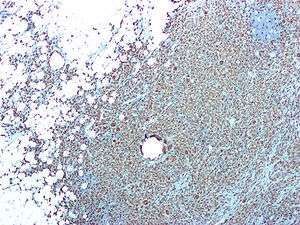CD68
| CD68 molecule | |
|---|---|
| Identifiers | |
| Symbol | CD68 |
| Entrez | 968 |
| HUGO | 1693 |
| OMIM | 153634 |
| RefSeq | NM_001251 |
| UniProt | P34810 |
| Other data | |
| Locus | Chr. 17 p13 |

CD68 (Cluster of Differentiation 68) is a glycoprotein which binds to low density lipoprotein.
It is expressed on monocytes/macrophages.[1][2]
The mouse equivalent is called "macrosialin".
Use in pathology
Immunohistochemistry can be used to identify the presence of CD68, which is found in the cytoplasmic granules of a range of different blood cells and myocytes. It is particularly useful as a marker for the various cells of the macrophage lineage, including monocytes, histiocytes, giant cells, Kupffer cells, and osteoclasts. This allows it to be used to distinguish diseases of otherwise similar appearance, such as the monocyte/macrophage and lymphoid forms of leukaemia (the latter being CD68 negative). Its presence in macrophages also makes it useful in diagnosing conditions related to proliferation or abnormality of these cells, such as malignant histiocytosis, histiocytic lymphoma, and Gaucher's disease.[3][4]
See also
References
- ↑ Osterne R, Matos-Brito R, Alves AP, et al. (February 2009). "Oral Granulocytic Sarcoma : A case report" (PDF). Med Oral Patol Oral Cir Bucal. 14 (5): E232–5. PMID 19218902. Archived from the original (PDF) on March 6, 2009.
- ↑ Holness CL, Simmons DL (March 1993). "Molecular cloning of CD68, a human macrophage marker related to lysosomal glycoproteins". Blood. 81 (6): 1607–13. PMID 7680921.
- ↑ Leong, Anthony S-Y; Cooper, Kumarason; Leong, F Joel W-M (2003). Manual of Diagnostic Cytology (2 ed.). Greenwich Medical Media, Ltd. pp. 135–136. ISBN 1-84110-100-1.
- ↑ Manduch M, Dexter DF, Jalink DW, Vanner SJ, Hurlbut DJ (January 2009). "Undifferentiated pancreatic carcinoma with osteoclast-like giant cells: Report of a case with osteochondroid differentiation". Pathol. Res. Pract. 205 (5): 353–9. doi:10.1016/j.prp.2008.11.006. PMID 19147301.
External links
- CD68 antigen, human at the US National Library of Medicine Medical Subject Headings (MeSH)
- CD68 protein, mouse at the US National Library of Medicine Medical Subject Headings (MeSH)